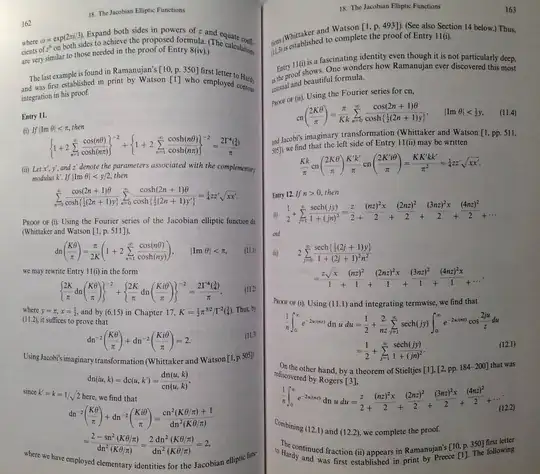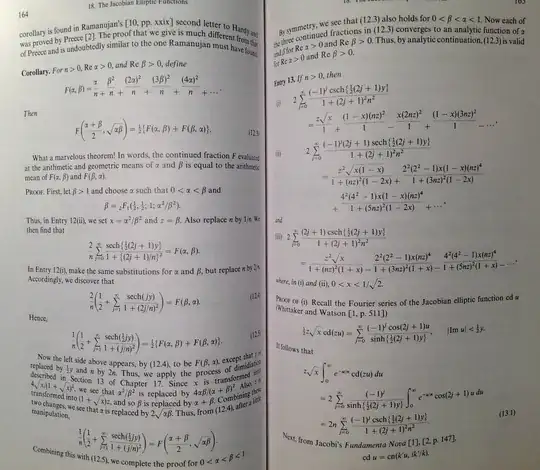In one of the comments to a question I posted on MSE, I got this wonderful continued fraction $$\int_{0}^{\infty}\frac{e^{-xt}}{\cosh t}\,dt = \frac{1}{x}\genfrac{}{}{0pt}{}{}{+}\frac{1^{2}}{x}\genfrac{}{}{0pt}{}{}{+}\frac{2^{2}}{x}\genfrac{}{}{0pt}{}{}{+}\frac{3^{2}}{x}\genfrac{}{}{0pt}{}{}{+\dots}\tag{1}$$ Another article here (search for "Conjecture 1") mentions that this is a conjecture for $x \geq 1$. I believe this formula $(1)$ should be true whenever both sides of the equation are defined.
Let me know if there is an elementary proof available for $(1)$.
Update: As mentioned in this comment the integral in $(1)$ can be easily shown to be equal to an infinite series as follows \begin{align} \int_{0}^{\infty}\frac{e^{-xt}}{\cosh t}\,dt &= 2\int_{0}^{\infty}\frac{e^{-xt}}{e^{t} + e^{-t}}\,dt\notag\\ &= 2\int_{0}^{1}\frac{v^{x}}{1 + v^{2}}\,dv \text{ (putting }v = e^{-t})\notag\\ &= 2\int_{0}^{1}\sum_{k = 0}^{\infty}(-1)^{k}v^{x + 2k}\,dv\notag\\ &= 2\sum_{k = 0}^{\infty}(-1)^{k}\int_{0}^{1}v^{x + 2k}\,dv\notag\\ &= 2\sum_{k = 0}^{\infty}\frac{(-1)^{k}}{x + 2k + 1}\notag \end{align}
Also it is mentioned there that there is a general result by Rogers which converts the above sum into the continued fraction on the right of $(1)$. If there are any references to this result of Rogers, it would be of great help here.
Further Update: It turns out that the continued fraction expansion mentioned above is quite helpful in approximating $\pi$.
 and
and  . Concerning Roger's $1907$ paper you may read/download it at archive.org. Start with Berndt's page $164$ substitutions to rewrite the c.f. in the p.$163$ form (I didn't reverify all this...). Hoping this helped a little,
– Raymond Manzoni
May 28 '15 at 00:35
. Concerning Roger's $1907$ paper you may read/download it at archive.org. Start with Berndt's page $164$ substitutions to rewrite the c.f. in the p.$163$ form (I didn't reverify all this...). Hoping this helped a little,
– Raymond Manzoni
May 28 '15 at 00:35